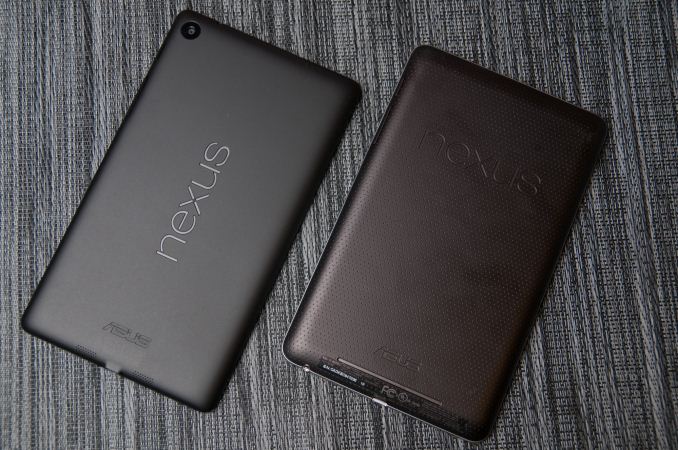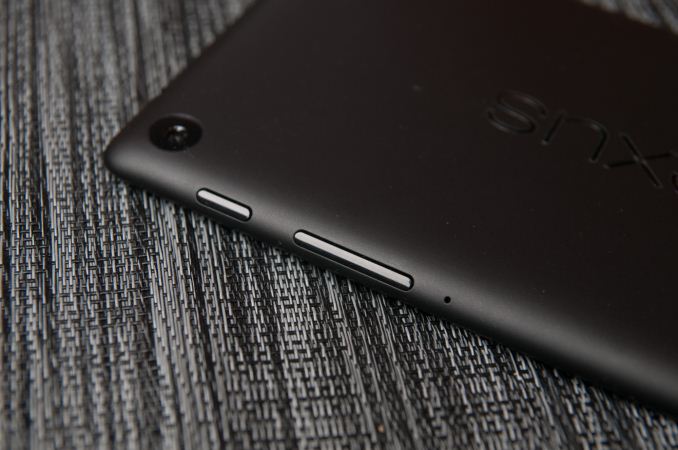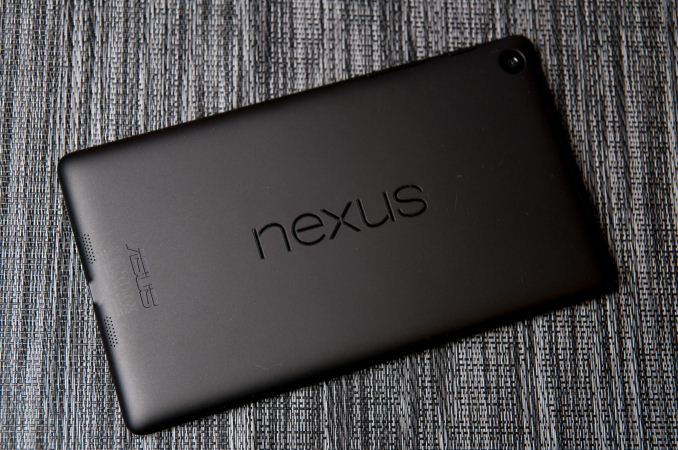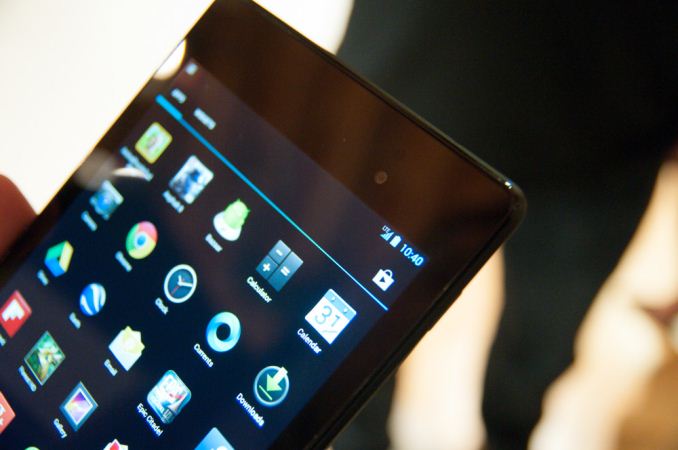Nexus 7 (2013) - Mini Review
by Brian Klug on July 27, 2013 12:54 AM EST- Posted in
- Tablets
- Snapdragon
- Qualcomm
- Android
- Mobile
- APQ8064
- Nexus 7
- Android 4.3

At an event in San Francisco, Google announced an updated version of the popular Nexus 7 tablet which first appeared at last year’s Google I/O. The big new features update the Nexus 7 platform with inclusion of a 1.5 GHz Snapdragon S4 Pro (APQ8064) SoC, 1920x1200 display by JDI (Japan Display Inc), as well as 5 MP rear facing camera, 1.2 MP front facing camera, stereo speakers, dual band WiFI, wireless charging (Qi) and a thinner and lighter chassis. It’s a major update that keeps the competitive price point that made the original Nexus 7 appealing (the lineup starts at $229 for the 16 GB model) while bringing numerous much-needed improvements that people have asked for.
First off, it’s shocking how much of a difference the change in thickness and weight makes. The new Nexus 7 feels considerably lighter and thinner in the hand than its older counterpart. Gone is the textured rubberized (almost driver glove-like) material on the back, in its place a flat, uniform soft touch material. There’s Nexus emblazoned in landscape on the rear, which is a bit puzzling next to the 90 degree rotated ASUS down below. It irritates my OCD sensibilities seeing the two logos inexplicably perpendicular and right next to each other, but I suppose Google thinks this helps emphasize how much the Nexus 7 and Android platform are really tablet-friendly now, with landscape view support throughout the core apps.
The rear facing camera is in the extreme top left, next to the power and volume rocker buttons, and top speaker. The Nexus 7 build and finish does feel a bit more plasticky to me this time around, but that’s almost expected given the price point, and it isn’t a major dig on the hardware at all. That’s not to say it isn’t sturdy or well put together, but just that the original Nexus 7 left a stronger impression on me last time, and I’ve been spoiled by the ASUS FonePad since then. The edge chamfer also helps the Nexus 7 feel a bit more like the Nexus 4 with its rounded edge. The previous Nexus 7 came to a point that could be a bit sharp at times.
What’s a little awkward is how tall the bezel at top and bottom looks on the Nexus 7, I’m warming up to it. On paper the new Nexus 7 is smaller in almost every dimension, in reality the elongated aspect ratio is definitely a bit pronounced here. There’s also still a notification LED well hidden under the glass at bottom in the center.
On the back is the new 5 MP rear facing camera, buttons (which hug the edges), a microphone port, and speakers. The speakers fire out the back of the Nexus 7 and look like they have good separation (obviously the best that the device’s size affords – top and bottom), but I don’t have a good feel for just how loud they go quite yet. Having stereo is a dramatic improvement for the audio part of video and multimedia consumption, and Android does 5.1 virtualization out the speakers as well. On the connectivity side of things there’s microUSB at the bottom with SlimPort video out, and a 3.5mm audio jack. I know a lot of people were hoping for inclusion of line in on the 3.5mm audio jack but I can confirm it isn’t present.
| Nexus 7Tablet Specification Comparison | ||||
| ASUS Nexus 7 (2012) | ASUS Nexus 7 (2013) | |||
| Dimensions | 198.5 x 120 x 10.45mm | 200 x 114 x 8.65mm | ||
| Chassis | Plastic + Rubber back | Plastic + Soft Touch back | ||
| Display | 7-inch 1280x800 IPS | 7.02-inch 1920x1200 IPS | ||
| Weight | 340 g | 290 grams (WiFi), 299 grams (LTE) | ||
| Processor | 1.3 GHz NVIDIA Tegra 3 (T30L - 4 x Cortex A9) | 1.5 GHz Qualcomm Snapdragon S4 Pro (APQ8064) | ||
| Memory | 1 GB | 2 GB DDR3L | ||
| Storage | 8 GB / 16 GB | 16 GB / 32 GB | ||
| Battery | 16 Whr | 15.01 Whr | ||
| WiFi/Connectivity | 802.11b/g/n, BT, NFC | 802.11a/b/g/n, BT 4.0, NFC | ||
| Camera | – |
5.0 MP Rear Facing w/AF 1.2MP Front Facing |
||
| Wireless Charging | – | Yes (Qi Compatible) | ||
| Pricing | $199/$249 |
$229/$269 (WiFi 16/32 GB) $349 (LTE) |
||
My only real complaint with the new Nexus 7’s in hand feel and build is with the power button and volume rocker, which feel somewhat mushy to me. I had issues taking screenshots even at times. It’s a minor gripe, but with only three buttons on the whole device, and generally good execution by ASUS with buttons on tablets, it surprised me. I guess I also do miss that racing glove-inspired texture in the soft touch on the back of the original Nexus 7.
| Nexus 7 (LTE) Band Coverage | |||||
| Model | GSM/EDGE Bands |
WCDMA Bands (HSPA+ 42) |
LTE Bands (UE Category 3) |
||
| North America Nexus 7 LTE |
Quad Band (850 / 900 / 1800 / 1900 MHz) |
HSPA+: 850/900/1900/2100/AWS(1700/2100) MHz (Bands: 1/2/4/5/8) | 700/750/850/1700/1900/2100 MHz (Bands: 1/2/4/5/13/17) | ||
| Europe Nexus 7 LTE | 800/850/1700/1800/1900/2100/2600 MHz (Bands: 1/2/3/4/5/7/20) | ||||
There’s a version of the Nexus 7 with 32 GB of storage and LTE onboard for $349 which will appear ‘in the coming weeks’ and includes support for AT&T, T-Mobile, and Verizon LTE in the USA on one piece of hardware. This is the first single SKU solution I’m aware of with coexistence of Bands 13 and 17 (Verizon and AT&T respectively) on the same device, which is awesome. There’s a model with Bands 3, 7, and 20 for Europe as well, so they’re not left out of the LTE fray. I had a chance to quickly get a look at the new Nexus 7 with LTE, which includes a microSIM tray and was working on one of the LTE networks in San Francisco just fine.
As far as I know, the Nexus 7 LTE solution is Qualcomm’s MDM9215 with a WTR1605L transceiver inside, and doesn’t necessarily include any of the new RF360 brand of front end hardware (like the power amplifier with integrated antenna switch or tunable front end), since MDM9x15 only works with QFE1320 (Bands 1,2,3/4,5,8,20). Still, that makes it all the more impressive, and Google deserves considerable kudos for further pushing such unprecedented interoperability, since in a tablet you do have more area to include discrete power amplifiers and filters.




















252 Comments
View All Comments
TheinsanegamerN - Saturday, July 27, 2013 - link
I would say that no removable memory is a concern, except that my 32 GB nexus 7 has been in heavy use for a year now, and ive only used 5 GB....and there are several apps that i dont use anymore. i dont think many people use more than 32 gb of storage.kmmatney - Saturday, July 27, 2013 - link
Agreed - the only time I ever have to free up space on my 16GB iPad is when the kids fill it with movies (somehow they prefer to use the iPad for movies, rather than using a phone or digital cameras).superflex - Monday, July 29, 2013 - link
Removable memory or storage?Big difference, Copernicus.
broberts - Tuesday, July 30, 2013 - link
Given that the device supports USB-OTG, adding an SD slot seems rather pointless. For the rare users that absolutely must have more than 32GB on-line, use a flash drive. Better yet, use the cloud or other storage on your LAN.lightsout565 - Saturday, July 27, 2013 - link
The amount of value the Nexus 7 represents in comparison to other Android tablets is extraordinary. I'm not sure Google would want to increase the cost of the tablet for something that wont positively increase the user's experience for 90% of people.nerd1 - Saturday, July 27, 2013 - link
They are INTENTIONALLY omitting a few features from their nexus devices so that OEM can still sell android stuff. Harm environment? LOL... Go blame apple who makes EVERY appliances non-repairable and non-upgradable, or disposable, to maximize profit.Broo2 - Saturday, July 27, 2013 - link
At the rate technology is changing, a 2 or 3 year old tablet will be obsolete as many mobile technologies are just starting to hit their stride;Have you tried to run some of the newer apps/games on an original Galaxy Tab? Apple even recognizes this as there will be no iOS 7 for the original iPad (released in 2010).I think it is more that Google is recognized the potential usable lifespan of their product (2-3 years) and decided to keep the design simple.
I found storage is an over-rated artificial need I clung to from the last decade; I went for a 64GB SDXC in my old Galaxy S3 and used perhpas 30% of it; I was streaming more music (Spotify/Google) and podcasts (DogCatcher) and only using the storage for audiobooks and some FLAC music- and Plex took care of all my video streaming needs. :)
Myrandex - Monday, July 29, 2013 - link
lol Apple isn't allowing iOS7? They didn't even allow iOS6. It was complete crap. They allowed iOS6 on an iPhone model that was older than the original iPad (the 3GS), but not on the iPad itself. My wife has an original iPad and it is stuck at its current iOS5 revision.broberts - Tuesday, July 30, 2013 - link
Most tablets in the price range and even many more expensive units (e.g. iPads) have no user replaceable parts. So it appears that your criteria eliminates most, if not all tables.There is a direct trade off between user replaceable/expandable parts and cost. Moreover, the cost of a battery plus additional RAM bought in single units is such that it is generally not much more expensive to buy and entirely new, mass produced unit. This is generally true, not only with tablets but with other technology, including automobiles.
The USB interface reportedly supports OTG so it is not inconceivable that one will be able to plug in externally powered SSD and hard drives as well as flash drives. And of course one can use any one of a number of Android apps that provide a connection to storage in your LAN or the cloud. So the lack of an SD slot is moot.
Battery life is not dependent on the number of charge cycles. Useful life is affected by the temperature at which they are stored and the pattern of use. I expect your 2 year usable life time is pessimistic except for the heaviest of users.
Kidster3001 - Friday, August 9, 2013 - link
Memory is not removable on any mobile device. I think you meant to say Storage. They are quite different. RAM (memory) vs HDD/SSD (Storage) is a good analogy to keep in mind.